Surrey
Explore hidden histories, historic photos, and things you never knew about Surrey from the collections and archives of Historic England.
Discover your local listed buildings and places
Introducing some of Surrey's most historic sites, included in the National Heritage List for England. Some of these captions have been summarised by AI. Click through for the official List entry. Skip this section and go to place by numbers
Norbury Park
Mickleham
Norbury Park, laid out by William Lock in the late 18th century, features picturesque grounds and a mansion designed by Thomas Sandby.
Peper Harow Park
Peper Harow
Mid-C18 landscape park designed by Lancelot 'Capability' Brown with buildings by William Chambers and AWN Pugin. Read the official list entry to find out more.
Tollsworth Manor House
Chaldon
Tollsworth Manor House, a 15th-century timber-framed building, features 17th-century stone cladding and 19th-century extensions.
Sutton Place
Send
Sutton Place is a significant example of Tudor domestic architecture, featuring gardens designed by Sir Geoffrey Jellicoe in the 1980s, enhancing its historical and cultural value.
Legal and General House, with hard landscaping including …
Kingswood
Legal and General House, of 1986-1991 by Arup Associates, with landscaping by Peter Swann Associates. Read the official list entry to find out more.
Busbridge Lakes
Godalming
Busbridge Lakes features 18th-century follies in a scenic valley with historical links to key figures such as Philip Carteret Webb and Chauncy Hare Townshend.
Garrison Church of St Barbara
Deepcut
Garrison Church of St Barbara at Deepcut Barracks, 1901. Read the official list entry to find out more.
The Station public house, formerly The Stoneleigh Hotel
Worcester Park and Stoneleigh
'Improved' public house, built as The Stoneleigh Hotel in 1934-5, by the brewery Truman, Hanbury, Buxton & Co. Ltd to the designs of A E Sewell.
Place Farm House including Cleves Cottage
Bletchingley
The Place Farm House, once the gatehouse to Bletchingley Place, was associated with Anne of Cleves post-divorce in 1540 after Henry VIII appropriated it.
Albury Park
Albury
Albury Park, with gardens designed by John Evelyn and remodeled by Henry Drummond, served as a spiritual center for the Catholic Apostolic Church in the 19th century.
Bofors Tower south of Burntwood Lane
Caterham-on-the-Hill
Bofors Tower, c1940. Read the official list entry to find out more.
Royal Holloway College
Egham
Royal Holloway College, built in the late 19th century by W H Crossland, features French 16th-century style architecture, sculptural details by Fucigna, and distinctive turrets and chimneys.
Chertsey Abbey: a Benedictine monastery on the banks of A…
Chertsey
Chertsey Abbey, a Benedictine monastery, significantly contributed to medieval religion and society, demonstrating influences on worship, learning, and economy.
The Jellicoe Roof Garden, Guildford
Guildford
Geoffrey Jellicoe's 1956-7 roof garden for Harvey's in Guildford was inspired by celestial themes and Sputnik, featuring a water garden to unite heaven and earth.
Munstead Wood
Godalming
Munstead Wood, designed by Edwin Lutyens for Gertrude Jekyll, showcases a collaboration that influenced garden and architectural design in early 20th-century Surrey for over fifty years.
Ash Manor and Old Manor Cottage
Ash
The building is a moated manor house thought to have C13 origins and with multiple phases including those of the C16 and C17.
Bourne Hall Library and Social Centre
Ewell
Public library and social centre, 1967-70 by A.G. Sheppard Fidler and Associates. Read the official list entry to find out more.
Painshill Park
Wisley
Charles Hamilton created Painshill Park between 1738 and 1773, blending natural and architectural beauty. The site, restored in the late 20th century, remains publicly accessible today.
Farnham Park
Farnham
Farnham Park, developed from a 14th-century deer park by Bishop North in the late 18th to early 19th centuries, features historical architectural elements and extensive pleasure grounds.
Woburn Farm
Addlestone
Woburn Farm was designed by Philip Southcote in 1734 and is notable for its picturesque landscape. It was admired for creating a peaceful rural atmosphere.
Wotton House
Wotton
Wotton House, set within historical mid 17th-century gardens designed by John and George Evelyn, underwent extensive changes over centuries and is currently a conference centre.
Pippbrook House
Dorking
Country house in the Gothic style, designed in 1856 by Sir George Gilbert Scott for William Henry Forman. Read the official list entry to find out more.
Compton Cemetery (also known as Watts Cemetery)
Compton
An Arts and Crafts cemetery laid out by Compton Parish Council and Mary Watts in 1895-8 and extended in 1950-2. Read the official list entry to find out more.
The Royal Estate, Windsor: Virginia Water (Including Fort…
Old Windsor
Virginia Water, part of Windsor Great Park, features a historic artificial lake created in the 1750s. It includes Fort Belvedere and Roman architectural ruins from Leptis Magna.
Oatlands
Weybridge
Oatlands evolved from a Tudor deer park for Henry VIII into a landscaped garden, featuring architectural contributions from Inigo Jones and frequenting historical figures like James I and...
Enton Mill and Enton Mill West
Witley and Milford
Corn Mill of circa 1621 and a contemporary adjoining mill house. Read the official list entry to find out more.
Ashtead Park
Ashtead
Ashtead Park, a 17th-century park, was developed in the 18th and 19th centuries and features historic buildings, managed gardens, and woodlands.
Moor Park
Farnham
Moor Park features late 17th-century formal gardens designed by Sir William Temple, visited by Jonathan Swift, later home to Charles Darwin.
St Ann's Hill and the Dingle
Runnymede
St Ann’s Hill, originally a prehistoric fort, became a landscaped public park in 1928. Known for its historical significance, it was landscaped by Percy Cane.
Walton Court, formerly Birds Eye Offices, including court…
Walton-on-Thames
Offices for Bird's Eye Foods, 1961-2 by architects Sir John Burnet, Tait and Partners, with Bylander, Waddell and Partners, engineers. Extended 1967-8. Landscape by Philip Hicks.
The Church of St Andrew
Farnham
St Andrew's Church, Farnham, is a Grade I listed medieval parish church with notable C12-C16 features, including a west tower and richly carved screens, emphasizing its historical and...
Shah Jahan Mosque
Woking
Purpose built mosque of 1888-1889. Read the official list entry to find out more.
Cemex House, formerly RMC House
Staines-upon-Thames
Headquarters building, designed from 1986 and built in 1988-89 to designs by Edward Cullinan Architects (ECA).
Church of St Peter and St Paul
Chaldon
The Church of St Peter and St Paul, originating from the 11th century, features significant 12th and 13th-century design elements, a 17-foot historical wall painting, and notable monuments.
The Moat Farm House Including Barn Attached to Right
Limpsfield
The Moat Farm House is a 15th-century hall house with 19th and 20th-century additions, featuring timber framing, stone and brick details, and an attached C19 barn.
Jellys Hollow
Cranleigh
Jellys Hollow is a timber-framed house with whitewashed brick, originally built in the late 16th or early 17th centuries.
Littleworth Cross (Formerly Hethersett)
Seale and Sands
Littleworth Cross is notable for its late 19th-century rhododendron hybrids and as the meeting place of Gertrude Jekyll and architect Edwin Lutyens in 1889.
Explore more
Search for more listed placesSurrey through time
This timeline shows the first period of use for buildings and places on the National Heritage List for England, just one of the details recorded for every list entry. Click around to see how Surrey changes over time. Skip this section and go to aerial photos
Prehistoric Before AD 43
Prehistory covers a million years of human occupation before the Roman invasion and the introduction of writing. Primarily hunter-gatherers of several human species including Neanderthals, the peoples moved across Europe, hunting animals, exchanging ideas and developing complex culture and belief systems including burial rites and astronomical understanding, as at Stonehenge for example.
Roman AD 43 to AD 410
Britain was invaded by four legions of the Roman army in AD 43, who relatively rapidly conquered England from landing points in Kent. Parts of Wales and Scotland soon followed.
Roman culture brought urbanism, monumental buildings, wide-ranging religious beliefs, writing, and strong social hierarchy. The Roman administrative system was withdrawn in AD 410.
Early medieval AD 410 to AD 1066
This period, often associated in England with Anglo-Saxons and Vikings, saw a reduction in urban living from the Roman period and increased migration from northern Europe.
Traces of this period can be found in cemeteries, particularly in artefacts and in some of the very early churches, as this period also saw the growth of Christianity in Britain.
Medieval AD 1066 to AD 1540
This period, sometimes known as the Middle Ages, began with the Norman invasion in AD 1066. It saw a significant rise in military and defensive buildings such as castles and earthworks, as well as religious houses dominating a largely agricultural landscape.
The monarchy and Church dominated the period, which also saw the break with the Roman Catholic Church and the English reformation.
Post medieval AD 1540 to AD 1901
The Post-Medieval period brought seismic changes to life in England, with religious reformation leading to the democratization of worship and the destruction of hundreds of religious houses.
In parallel, there was a huge expansion of scientific study and enlightenment that permanently altered the nation's social structure and landscape. Industrialization and mass production lead to wider global trade, emigration, and immigration.
20th century AD 1901 to AD 2000
The 20th century saw an incredible expansion of England's transport networks, with suburban growth shadowing rapid infrastructural expansion. The establishment of state schools, hospitals, and modern technical colleges, with new architectural styles, radically changed the appearance of towns and cities.
Two catastrophic world wars and the 1918 pandemic also brought unprecedented change, altering England's built environment and social structures forever.
Prehistoric Before AD 43
Prehistory covers a million years of human occupation before the Roman invasion and the introduction of writing. Primarily hunter-gatherers of several human species including Neanderthals, the peoples moved across Europe, hunting animals, exchanging ideas and developing complex culture and belief systems including burial rites and astronomical understanding, as at Stonehenge for example.
Roman AD 43 to AD 410
Britain was invaded by four legions of the Roman army in AD 43, who relatively rapidly conquered England from landing points in Kent. Parts of Wales and Scotland soon followed.
Roman culture brought urbanism, monumental buildings, wide-ranging religious beliefs, writing, and strong social hierarchy. The Roman administrative system was withdrawn in AD 410.
Early medieval AD 410 to AD 1066
This period, often associated in England with Anglo-Saxons and Vikings, saw a reduction in urban living from the Roman period and increased migration from northern Europe.
Traces of this period can be found in cemeteries, particularly in artefacts and in some of the very early churches, as this period also saw the growth of Christianity in Britain.
Medieval AD 1066 to AD 1540
This period, sometimes known as the Middle Ages, began with the Norman invasion in AD 1066. It saw a significant rise in military and defensive buildings such as castles and earthworks, as well as religious houses dominating a largely agricultural landscape.
The monarchy and Church dominated the period, which also saw the break with the Roman Catholic Church and the English reformation.
Post medieval AD 1540 to AD 1901
The Post-Medieval period brought seismic changes to life in England, with religious reformation leading to the democratization of worship and the destruction of hundreds of religious houses.
In parallel, there was a huge expansion of scientific study and enlightenment that permanently altered the nation's social structure and landscape. Industrialization and mass production lead to wider global trade, emigration, and immigration.
20th century AD 1901 to AD 2000
The 20th century saw an incredible expansion of England's transport networks, with suburban growth shadowing rapid infrastructural expansion. The establishment of state schools, hospitals, and modern technical colleges, with new architectural styles, radically changed the appearance of towns and cities.
Two catastrophic world wars and the 1918 pandemic also brought unprecedented change, altering England's built environment and social structures forever.
Aerial photos of Surrey
Aerial photography helps reveal secrets of England's changing landscapes that are impossible to see from the ground. Skip this section and go to archive images

Guildford
The Cathedral Church of the Holy Spirit under construction, Guildford, 1949
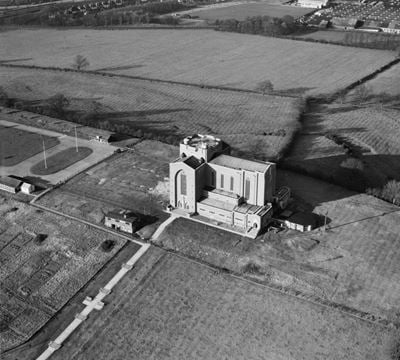
Guildford
The Cathedral Church of the Holy Spirit under construction, Guildford, 1952

Englefield Green
Royal Holloway College, Englefield Green, 1923
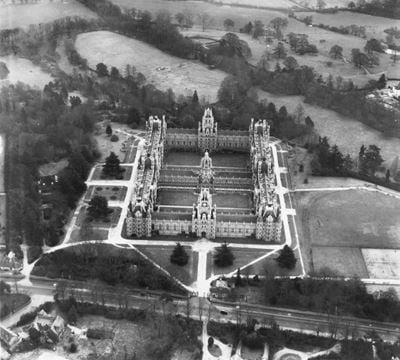
Englefield Green
Royal Holloway College, Englefield Green, 1949
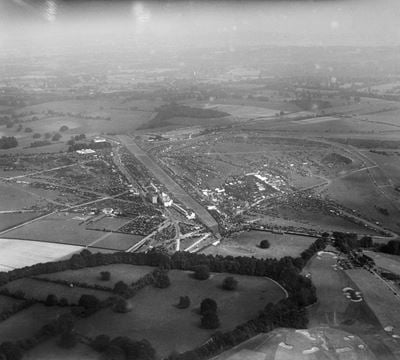
Epsom Downs
Epsom Racecourse on Derby Day, Epsom Downs, 1921
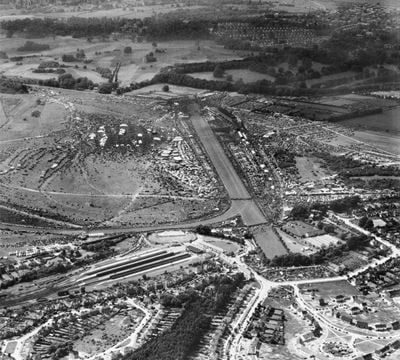
Epsom Downs
Epsom Downs, Derby Day, 1953
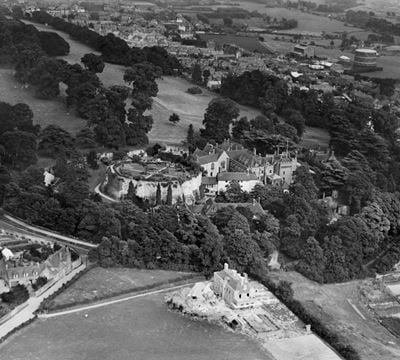
Farnham
Farnham Castle, Farnham, 1928
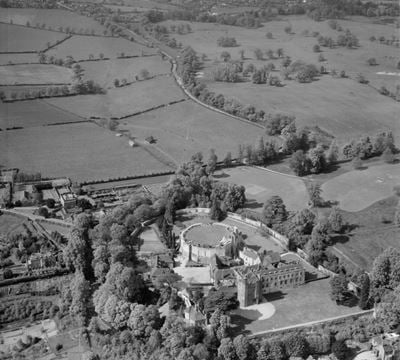
Farnham
Farnham Castle and Folly Hill, Farnham, 1953
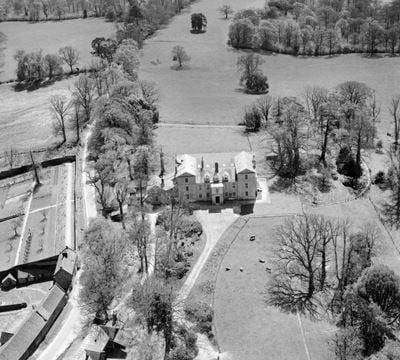
Leith Hill
Leith Hill Place, Leith Hill, 1947

Leith Hill
Leith Hill Place and surrounding countryside, Leith Hill, 1947
Surrey in the Historic England Archive
The Historic England Archive cares for over 15 million images, dating from the 1850s to the present day. Discover stunning images of Surrey's past. Skip this section and go to stories about heritage
Charles George Harper Collection
Waverley, Surrey
Date created: 1892 - 1933
A man and a woman outside the front of Church Steps, with the spire of All Saints' Church in the background
Eric de Mare
Waverley, Surrey
Date created: 1945 - 1980
Elstead Mill, on the River Wey, viewed from the south
John Gay Collection: London
River Thames, Greater London Authority
Date created: 1946 - 1964
Elevated view of boats on the River Thames, with cranes in the foreground
John Gay Collection: Modern Architects
Waverley, Surrey
Date created: 1969 - 1973
Looking from Pound Lane towards the modern commercial development at 48 to 56 High Street, Godalming
John Gay Collection: Rural Life
Surrey
Date created: 1946 - 1960
The tail of a hunter hanging from its horse box at a hunt meet
John Gay Collection: Miscellaneous
Guildford, Surrey
Date created: 1949 - 1951
An elderly male volunteer at Guildford Citizens' Advice Bureau provides a woman with some information from a volume of papers
John Gay Collection: Counties
Waverley, Surrey
Date created: 1950s - 1960s
View along a road near Haslemere, showing trees growing on its steep sided banks
John Laing Collection
Mytchett, Surrey Heath, Surrey
Date created: 14 Jul 1998
Two members of Laing's Elstree Senior Citizens Club in friendly conversation during an outing to the Basingstoke Canal Centre
Nigel Temple Collection of Postcards of Parks and Gardens
Waverley, Surrey
Date created: 1931 - 1936
GENERAL VIEW LOOKING DOWN ONTO CHARTERHOUSE HILL
Charles George Harper Collection
Waverley, Surrey
Date created: 1892 - 1933
Two men talking by a mounting block in front of Church Steps
John Gay Collection: Counties
Waverley, Surrey
Date created: 1950s - 1960s
Close up of bluebells growing beside a tree trunk
Stories about heritage in your local area
Historic England publishes news, blogs, research, videos, and podcasts celebrating England's rich heritage. Discover the stories we have about Surrey. Skip this section and go to education
How We Built Suburbia: The Development of England’s Suburbs
Mentions Shah Jahan Mosque
Over the past 2 centuries, England’s towns and cities have experienced unparalleled growth, which has led to the creation of the suburbs.
10 Lesser Known Places Linked to King Henry VIII
Mentions Nonsuch Palace, its formal gardens and associated remains, and Cuddington medieval settlement
Discover the lesser-known historic sites linked to Henry VIII, including Whitehall Palace, Windsor Castle, Rievaulx Abbey, and Eltham Palace, London.
Photographing the First World War on the Home Front
Mentions Muslim Burial Ground
Life changed on the home front in England during the First World War. This photography collection provides a glimpse into what it was like.
Battles, Castles and Ships: England’s Military History from the Air
Mentions Commonwealth Air Forces Memorial
Discover England's military history through aerial photography from the Aerofilms Collection.
The Buildings of Architect Ernő Goldfinger
Mentions Benjamins Mount and Attached Steps
Discover the modernist buildings of Hungarian-born architect Ernő Goldfinger, including Trellick Tower, Balfron Tower and 2 Willow Road.
The History of Brick Building in England
Mentions Cathedral Church of the Holy Spirit
Discover 7 examples of how brick building in England has changed over the centuries.
16 Historic Gardens and Landscapes to Visit
Mentions Royal Horticultural Society's Gardens, Wisley
Try these English gardens if you’re looking for somewhere with spectacular garden scenery.
7 Serene Cemeteries to Visit in England
Mentions Brookwood Cemetery
These graveyards can offer space for quiet reflection or a peaceful walk.
5 Listed Pub Signs in England
Mentions Sign 5 Yards North of the White Hart Inn
Take a look at these historic calling cards for pubs and inns across England.
A Brief History of Community Centres in England
Mentions Church of St Mary
Community centres emerged in the late 19th century through a variety of social movements.
A History of Cycling in the 19th Century
Mentions The Anchor Public House, Church of St Mary the Virgin
Discover the history of cycling and the development of the bicycle and penny-farthing in the 19th century.
What is a Tin Tabernacle?
Mentions Garrison Church of St Barbara
Pre-fabricated churches, often called ‘iron churches’, ‘iron chapels’ or ‘tin tabernacles’, were developed in the mid-19th century.
Mentions Surrey
The intricately designed Tudor chimneys that decorate Hampton Court Palace's skyline were originally installed as a stately symbol of wealth.
Conserving Hampton Court Palace's Iconic Chimneys
The intricately designed Tudor chimneys that decorate Hampton Court Palace's skyline were originally installed as a stately symbol of wealth.
17 Remarkable Historic Places Listed in 2024
Mentions Wonersh United Reformed Church, Surrey
Celebrating 17 historic gems that were examined, protected and added to the National Heritage List for England in 2024.
Managing Lithic Sites
Mentions Surrey
New advice addresses research and management issues for sites where prehistoric stone tools contain unique evidence.
500 Years of Oasts and Hop Kilns in England
Mentions Surrey
An overview of the research behind a recent Historic England book, which tells the story of hop processing.
The Origins and Use of Medieval Glazing in England
Mentions Surrey
Researching window glass from England’s medieval abbeys.
34 Belsize Lane Listed
Mentions Surrey
A unique 1970s studio house in Camden, London designed by British Architect Georgie Wolton has been listed at Grade II.
A Preview of The Sir John Pennycuick Collection for Researchers
Mentions Surrey
The Historic England Archive's Sir John Pennycuick Collection provides a photographic record of streets in early and mid-20th century England.
Harlow New Town Roman Catholic Church Upgraded to Grade II* Listing
Mentions Surrey
The Roman Catholic Church of Our Lady of Fatima in Harlow has been upgraded to Grade II* by DCMS on the advice of Historic England.
Places of Joy: the Role of Heritage During the COVID-19 Pandemic
Mentions Surrey
Research examining the ways that people are using heritage sites to support their wellbeing during the COVID-19 pandemic.
Historic England Highlights Captivating Heritage Sites Listed in 2021
Mentions Durbins,, Motor car house to Durbins, Surrey
Highlights from over 400 historic places which have been added to or amended on the National Heritage List for England in 2021.
132 Nationwide War Memorials Listed Ahead of Armistice Day
Mentions Bridley Manor War Memorial, Surrey
Built in the aftermath of the First World War, the memorials listed since last November are among tens of thousands erected across England.
Heritage at Risk in England Revealed in 2020
Mentions Church of St Mary, Surrey
Historic England has revealed the historic sites most at risk of being lost forever as a result of neglect, decay or inappropriate development.
Unusual Second World War Sites Listed and Upgraded to Mark the 80th Anniversary of the Battle of Britain
Mentions Boys' Air Raid Shelter at St John’s Primary School, Redhill, Surrey
Four new listings are highlighted alongside three other sites either upgraded or re-listed which show how the Battle has left its mark across England.
Surrey's social history through photos
Over 10,000 images from the Historic England Archive have been specially selected and re-captioned for teachers, students, and anyone who wants to learn more about their local area. Skip this section and go to grant-aided places
Workshop at Royal Earlswood Hospital, Redhill, Surrey
Period: Victorian (1837 - 1901)
This building is dated 1861. It was built as a laundry, boot room and boiler shop at what was the 'Earlswood Asylum for Idiots and Imbeciles'.
Workshop at Royal Earlswood Hospital, Redhill, Surrey
Worcester Park, Ewall, Surrey
Period: 1930s (1930 - 1938)
This house was built in 1937 by Connall, Ward and Lucas. It is in the Modern Movement style of architecture.
Worcester Park, Ewall, Surrey
Woodlands School, Fortyfoot Road, Leatherhead, Surrey
Period: 1970s (1970 - 1979)
Looking towards Woodlands School with the play area in the foreground
Woodlands School, Fortyfoot Road, Leatherhead, Surrey
Wayneflete's Tower, Esher, Surrey
Period: Medieval (Middle Ages) (1066 - 1484)
This is the former gatehouse to Esher Place Manor House. It was built in 1475-80, probably by John Cowper for Bishop Waynefleet of Winchester.
Wayneflete's Tower, Esher, Surrey
Virginia Water, The Ruins, Virginia Water, Egham, Surrey
Period: Victorian (1837 - 1901)
Exterior view of the Ruins at Virginia Water. They were erected by Jeffrey Wyattville to suggest the remains of an ancient temple.
Village Cage, Lingfield, Surrey
Period: Georgian (1714 - 1836)
The former village cage or lockup. Before a national system of policing was set up many villages had their own form of lockup or jail.
Village Cage, Lingfield, Surrey
Town Hall, Staines, Surrey
Period: Victorian (1837 - 1901)
The large Italianate building, constructed by J. P. Hearson in 1871-1880, taken across the river Thames.
Town Hall, Staines, Surrey
Tinman's Row, Cobham, Surrey
Period: Georgian (1714 - 1836)
This row of 8 ironworkers' cottages were built in c1803. They were built for Alexander Raby of Cobham Park. He was the owner of Downside Mill.
Tinman's Row, Cobham, Surrey
Visit grant-aided places near you
These places and buildings have been helped by Historic England's financial grants. Find historic places in your neighbourhood that you never knew existed! Please note that opening times may vary. Skip this section and go to related locations
Muslim Burial Ground, Monument Road
Architect T.H. Winney's 1917 creation on Horsell Common is the resting place for 19 WWI and eight WWII Muslim soldiers.
Discover more
Ready for more local heritage? Take a look at these other places nearby

Woking
Local Authority District
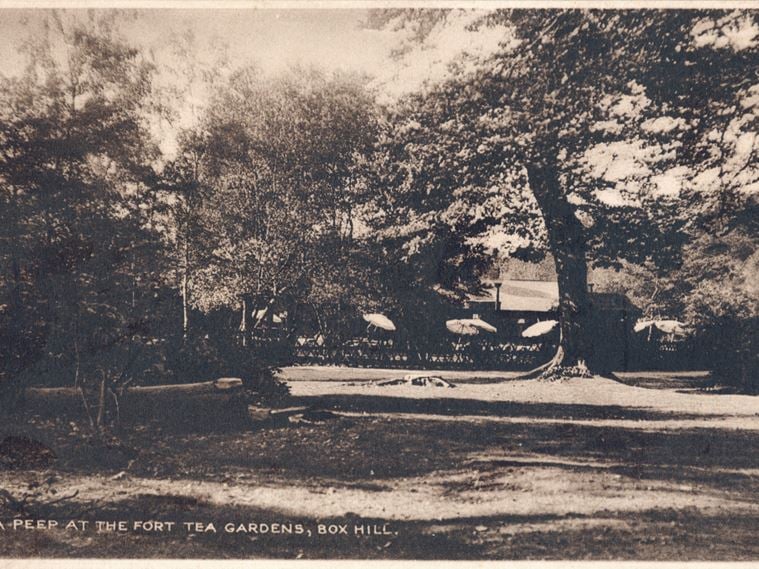
Mole Valley
Local Authority District
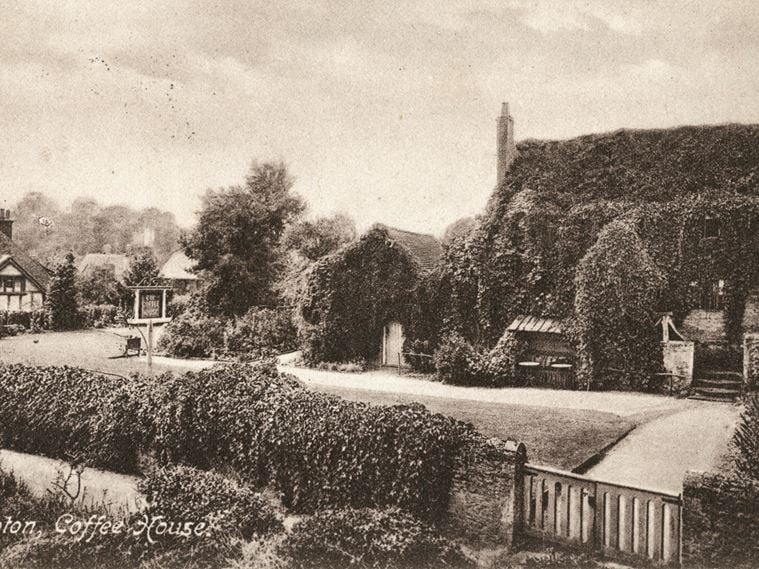
Guildford
Local Authority District